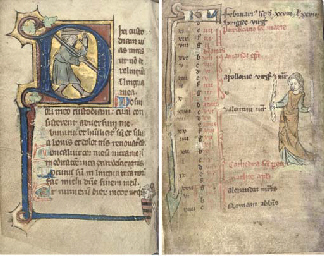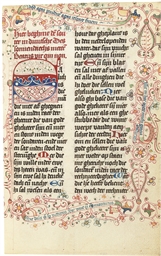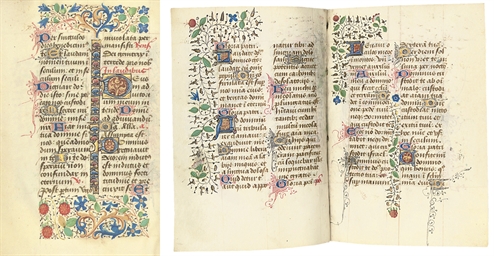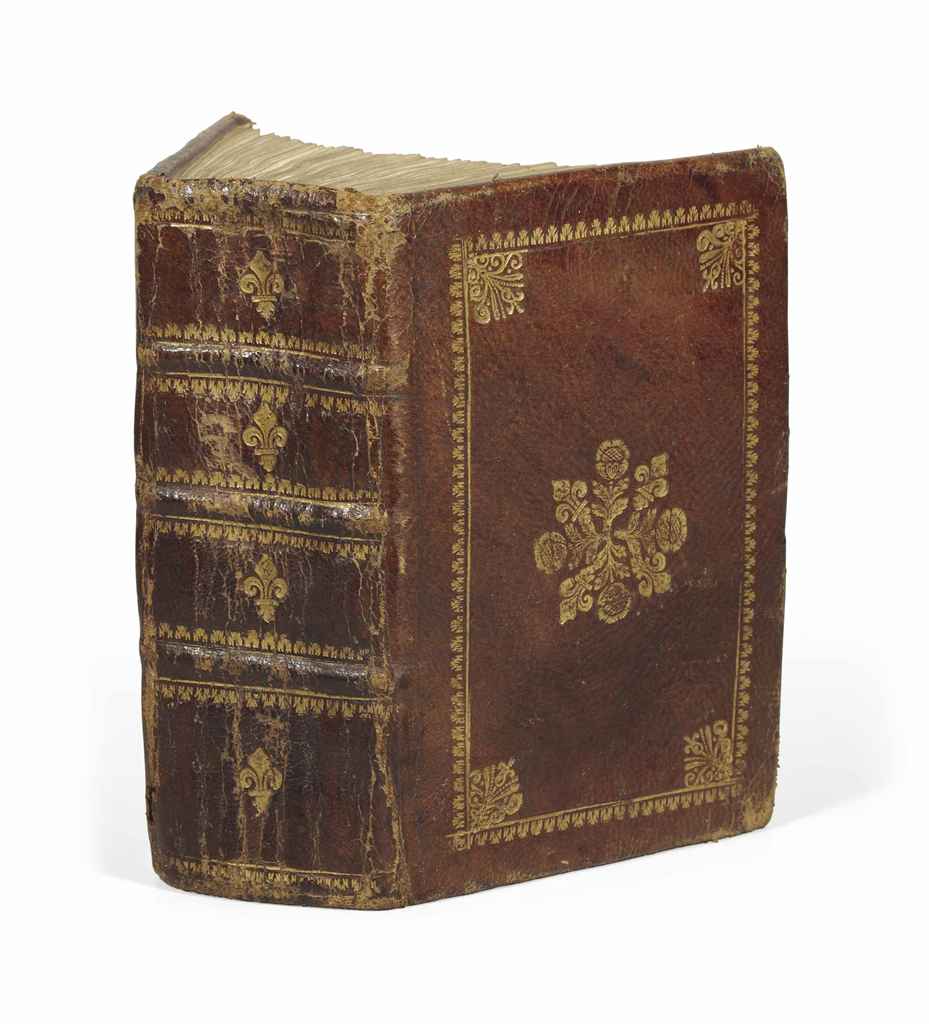PSALTER, with Calendar, Canticles and Litany, in Latin, ILLUMINATED MANUSCRIPT ON VELLUM [Liège, 1270s] 169 x 120mm. 117 leaves: 1 and 2 3 (each of three single leaves sewn together, missing one leaf with Beatus Vir initial and probably lacking further leaves with prefatory miniatures), 3-5 8 , 6 7 (of 8, lacking ii with historiated initial), 7-16 8 , lacking leaves at end, 23 lines in black ink in a gothic bookhand between two verticals and 24 horizontals ruled in grey, one-line initials alternately of red and blue, two-line initials of burnished gold against grounds and infills of pink and blue with white decoration, TWELVE CALENDAR ILLUSTRATIONS of the occupations of the months, EACH FIGURE ROBED IN HIGHLY BURNISHED GOLD and over half the height of the text, TEN LARGE HISTORIATED INITIALS with staves of blue or pink extending into the margins against grounds of burnished gold to form part borders (around thirty leaves darkened and text slightly abraded, slight cropping of initial extensions in upper margins, occasional smudging of ink outlines affecting two calendar figures and four historiated initials). 19th-century panelled red morocco by Budden with spine in six compartments (two bands scuffed). PROVENANCE: 1. The Calendar includes all the significant feasts of the Liège diocese: the names of Sts Domitian, Servatius and Remaclus (bishops of Tongres and Maestricht) and Theodardus, Hubert and three feasts of Lambert (bishops of Liège), for example, are all shown as major by being lined through with red. The manuscript's origin in Liège is confirmed by the style and iconography of the illumination, which show it to have been produced in an atelier active in the city during the 1260s and 70s. There is no indication of the individual for whom it was made but several of the related manuscripts were made for Béguines, female members of a semi-religious sisterhood founded in the 12th century, and said to have been named after Lambert le Bègue ('the stammerer'), a Liège preacher. 2. John Gilchrist Clark: his inscription, with the date 1851, on the second paper flyleaf. Mr Clark, the great-grandfather of the present owner, bought this manuscript, and lot 18, in Paris on his way home from the Grand Tour. CONTENT: Calendar ff.1-6v; Psalter ff.7-111 (lacking openings of Psalms 1 and 38 with historiated initials); Canticles ff.111-117; beginning of the Litany ff.117-117v The composition of stylistically related Psalters makes it likely that the Litany here was once followed by further devotions, among them Hours of the Virgin. These Psalter-Hours represent a distinctive and early phase in the evolution of lay devotional texts on the way towards the overwhelming popularity of the Book of Hours. ILLUMINATION: The sequence of large-scale golden-clad figures labouring in the Calendar make this one of the most arresting of the Psalters to be produced in Liège during the 13th century. Style and iconography show it to be the work of one of the most influential and important ateliers active in the city, one that is discussed by Professor Judith Oliver and characterised as having brought French High Gothic style to the diocese of Liège: Gothic Manuscript Illumination in the Diocese of Liège: c.1250-c.1330 (1988), pp.148-158. Professor Oliver identified three of the artists who worked on the Hainault Bible -- the multi-volume folio Bible also known as the Glazier-Rylands Bible, now dispersed among nine different collections -- who migrated into the diocese of Liège and there painted, among other manuscripts, a Psalter now in Paris (BnF, latin 1077). The present Psalter was painted by the illuminator responsible for many of the historiated initials in the Paris manuscript. One of the other Psalters attributed to this atelier as a work of the 1270s, although the work of a different artist, has particular relevance to the present manuscript. The Calendar illustrations of Princeton Art Museum 57 are clearly based on the same workshop mode
PSALTER, with Calendar, Canticles and Litany, in Latin, ILLUMINATED MANUSCRIPT ON VELLUM [Liège, 1270s] 169 x 120mm. 117 leaves: 1 and 2 3 (each of three single leaves sewn together, missing one leaf with Beatus Vir initial and probably lacking further leaves with prefatory miniatures), 3-5 8 , 6 7 (of 8, lacking ii with historiated initial), 7-16 8 , lacking leaves at end, 23 lines in black ink in a gothic bookhand between two verticals and 24 horizontals ruled in grey, one-line initials alternately of red and blue, two-line initials of burnished gold against grounds and infills of pink and blue with white decoration, TWELVE CALENDAR ILLUSTRATIONS of the occupations of the months, EACH FIGURE ROBED IN HIGHLY BURNISHED GOLD and over half the height of the text, TEN LARGE HISTORIATED INITIALS with staves of blue or pink extending into the margins against grounds of burnished gold to form part borders (around thirty leaves darkened and text slightly abraded, slight cropping of initial extensions in upper margins, occasional smudging of ink outlines affecting two calendar figures and four historiated initials). 19th-century panelled red morocco by Budden with spine in six compartments (two bands scuffed). PROVENANCE: 1. The Calendar includes all the significant feasts of the Liège diocese: the names of Sts Domitian, Servatius and Remaclus (bishops of Tongres and Maestricht) and Theodardus, Hubert and three feasts of Lambert (bishops of Liège), for example, are all shown as major by being lined through with red. The manuscript's origin in Liège is confirmed by the style and iconography of the illumination, which show it to have been produced in an atelier active in the city during the 1260s and 70s. There is no indication of the individual for whom it was made but several of the related manuscripts were made for Béguines, female members of a semi-religious sisterhood founded in the 12th century, and said to have been named after Lambert le Bègue ('the stammerer'), a Liège preacher. 2. John Gilchrist Clark: his inscription, with the date 1851, on the second paper flyleaf. Mr Clark, the great-grandfather of the present owner, bought this manuscript, and lot 18, in Paris on his way home from the Grand Tour. CONTENT: Calendar ff.1-6v; Psalter ff.7-111 (lacking openings of Psalms 1 and 38 with historiated initials); Canticles ff.111-117; beginning of the Litany ff.117-117v The composition of stylistically related Psalters makes it likely that the Litany here was once followed by further devotions, among them Hours of the Virgin. These Psalter-Hours represent a distinctive and early phase in the evolution of lay devotional texts on the way towards the overwhelming popularity of the Book of Hours. ILLUMINATION: The sequence of large-scale golden-clad figures labouring in the Calendar make this one of the most arresting of the Psalters to be produced in Liège during the 13th century. Style and iconography show it to be the work of one of the most influential and important ateliers active in the city, one that is discussed by Professor Judith Oliver and characterised as having brought French High Gothic style to the diocese of Liège: Gothic Manuscript Illumination in the Diocese of Liège: c.1250-c.1330 (1988), pp.148-158. Professor Oliver identified three of the artists who worked on the Hainault Bible -- the multi-volume folio Bible also known as the Glazier-Rylands Bible, now dispersed among nine different collections -- who migrated into the diocese of Liège and there painted, among other manuscripts, a Psalter now in Paris (BnF, latin 1077). The present Psalter was painted by the illuminator responsible for many of the historiated initials in the Paris manuscript. One of the other Psalters attributed to this atelier as a work of the 1270s, although the work of a different artist, has particular relevance to the present manuscript. The Calendar illustrations of Princeton Art Museum 57 are clearly based on the same workshop mode














Try LotSearch and its premium features for 7 days - without any costs!
Be notified automatically about new items in upcoming auctions.
Create an alert